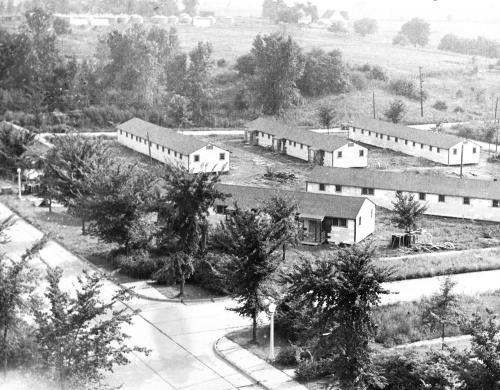Campus Life in the Barracks
January 16, 2018

Veterans Village
[Download Print-Quality Image]
By Marshall E. Stoner BS '56 MS.Ed. '60*
Sidebar to "There's No Place Like Home: Housing at WIU"
From the Fall 2017 Western: The Magazine for Alumni of Western Illinois University
The Western campus in those days would hardly be recognizable to today's students. Housing was somewhat of a hodge-podge affair with a majority of students living off campus in private homes. There was but one dormitory and that was for ladies only, named Monroe (Grote) Hall. The first men's dorm, Seal Hall, was a few years away, which brings up an unusual arrangement designed to accommodate some athletes. Western had purchased and moved three Army barracks from Camp Ellis, an Army camp located near Macomb between the towns of Table Grove and Ipava. The Army had used that camp during World War II and at one time accommodated several thousand German war prisoners.
But at Western in the mid-1950s, the barracks were used to house members of the football and basketball teams. Designated as Barracks 1, 2, and 3, the first two were assigned mainly to the football team and Barracks 3 was for the basketball players. The barracks were located adjacent to Morgan Gym, with a small front porch facing the sidewalk leading to the student union. Primitive comes fairly close to describing the make-up of the establishments. The college merely built eight-foot high partitions walling off spaces 10 feet by 15 feet, and each space would accommodate two people. The bunk beds came with the barracks from the Army camp. There was a community john and shower at one end and one centrally located ceiling heater. There was no air conditioning, but each room had a window. Winter time saw some very interesting developments as the end rooms, far away from the heater, had vastly different temperatures than the rooms near the heater. Needless to say, there were a few confrontations regarding whether to turn the thermostat up or down.
Can you imagine what life was like some nights with everyone tucked in, and most everyone still awake and the only thing separating a person was that pencil thin plywood partition that only stretched eight feet high? Privacy was an afterthought. And if there was a poker game in one of the rooms, it might as well, from a noise stand point, been in all of the rooms. Somehow the movie "Animal House" comes to mind. One incident describes the kind of togetherness that life in the barracks tended to construe. Depicting it here cannot possibly do justice to actually being there. But one evening a rarity occurred. Everyone was in bed. Someone made a sound that was intended to be a jungle noise. Then a second noise and a third. Eventually, everyone was participating in a symphony of jungle noise. It was hilarious for about 15 minutes, but as reported above, you had to be there.
However, there were a few perks to living in the barracks. The rent was unbelievably reasonable, as it was approximately $10 a month and the location was great for checking out the ladies who had to walk the nearby sidewalk to get to the student union.
---
* Editor's Note: Following WWII, numerous veterans came to WIU to continue, or begin, their education. In order to house a large number of male students, President Frank Beu acquired three Army barracks. The barracks were reassembled on campus behind Monroe (later called Grote) Hall. By the end of 1946, 10 other barracks buildings were placed on the southwest corner of campus, where Corbin-Olson stand today. Divided into apartments that were primarily for married students, those barracks were eventually known as "Veterans Village."
Posted By: University Communications (U-Communications@wiu.edu)
Office of University Communications & Marketing

Connect with us: